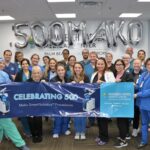Tampas new Alzheimers research center supports scientists and patients alike
By 2025, 64 percent more people in Florida will suffer from Alzheimers disease, according to the Alzheimers Association. Nationwide, the organization expects the highest growth of Alzheimers cases will be concentrated in the western and southeastern states particularly Florida.
In 2005, the National Institute on Aging awarded $7.5 million in federal grant money to the Health Sciences Center of the University of South Florida in Tampa to help establish Floridas first Alzheimers disease research center, with an eye toward finding a cure. Projected to open on campus in early 2007, The Johnnie B. Byrd Sr. Alzheimers Center and Research Institute will support not only research, but also advanced clinical trials and an education center. The 100,000-square-foot facility will become the nations largest Alzheimers research center.

Johnnie B. Byrd Sr. Florida Alzheimer’s Center and Research Institute, Tampa, Florida
Photo credits: HDR
Research Areas
The critical challenge was to create spaces that encourage collaboration among researchers in eight scientific teams. Facility designers came up with a seven-story lab tower based on an open plan. This design promotes interaction and idea exchange, which will lead more quickly to new findings.
The designers also created a prominent staircase inside the labs floor plate. It provides researchers with easy between-floor access, as well as opportunities for spontaneous discussion. To facilitate interaction, the plan avoids closing off floors for security, including the requirement that floors be connected by elevators. To that end, stairs are placed close to eating and gathering areas.
Each lab floor will create additional collaborative opportunities via formal and informal conference and meeting areas. Small, open seating zones located at the ends and centers of main corridors are adjacent to the core lab work centers for easy access.
Clinical Spaces
The patient clinic included within the institute will give researchers the opportunity to see immediate testing results and thus process data more quickly. However, designers were challenged to create a homelike, comfortable atmosphere within the research setting.
First, the clinic is completely separated from upper-floor labs, but remains convenient to the main entrance. Next, to achieve an appropriate comfort level for patients and their families, designers incorporated intimate spaces, soothing colors, aquarium tanks and supportive furniture.
A dedicated imaging area stands adjacent to the clinical area for easy patient access. Patient safety features such as hand railings and wayfinding treatments also contribute to the clinics positive atmosphere.
Education Outreach
The state of Florida itself, through its Division of Disease Control, works to diagnose, treat and prevent Alzheimers disease. To support that mission, the Byrd Institute offers a physical location for the state to coordinate its efforts. A data center and conferencing facilities provide spaces for researchers to discuss and process information. This way, researchers throughout Florida and the global research community may collaborate to find cures and preventive treatments.
The facility has a prominent position on campus, owing to its placement on an earth podium above road level. The higher location enhances the institutes visibility and accessibility. An added benefit is that the positioning creates a lower level used as a vivarium. This location provides security for sensitive animal care activities.
By planning for high-frequency collaboration, intense investigation and information outreach, the new Byrd Alzheimers Research Institute will provide the state and the nation with new hope for accelerated advancements in Alzheimers disease prevention–for generations to come.
Post Views: 670

























